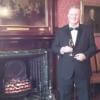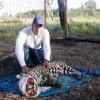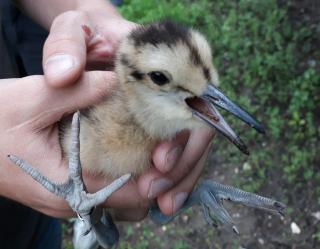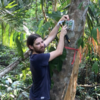Acoustic sensors enable efficient and non-invasive monitoring of a wide range of species, including many that are difficult to monitor in other ways. Although they were initially limited in application scope largely due to cost and hardware constraints, the development of low-cost, open-source models like the Audiomoth in recent years has increased access immensely and opened up new avenues of research. For example, some teams are using them to identify illicit human activities through the detection of associated sounds, like gunshots, vehicles, or chainsaws (e.g. OpenEars).
With this relatively novel dimension of wildlife monitoring rapidly advancing in both marine and terrestrial systems, it is crucial that we identify and share information about the utility and constraints of these sensors to inform efforts. A recent study identified advancements in hardware and machine learning applications, as well as early development of acoustic biodiversity indicators, as factors facilitating progress in the field. In terms of limitations, the authors highlight insufficient reference sound libraries, a lack of open-source audio processing tools, and a need for standardization of survey and analysis protocols. They also stress the importance of collaboration in moving forward, which is precisely what this group will aim to facilitate.
If you're new to acoustic monitoring and want to get up to speed on the basics, check out these beginner's resources and conversations from across the WILDLABS platform:
Three Resources for Beginners:
- Listening to Nature: The Emerging Field of Bioacoustics, Adam Welz
- Ecoacoustics and Biodiversity Monitoring, RSEC Journal
- Monitoring Ecosystems through Sound: The Present and Future of Passive Acoustics, Ella Browning and Rory Gibb
Three Forum Threads for Beginners:
- AudioMoth user guide | Tessa Rhinehart
- Audiomoth and Natterjack Monitoring (UK) | Stuart Newson
- Help with analysing bat recordings from Audiomoth | Carlos Abrahams
Three Tutorials for Beginners:
- "How do I perform automated recordings of bird assemblages?" | Carlos Abrahams, Tech Tutors
- "How do I scale up acoustic surveys with Audiomoths and automated processing?" | Tessa Rhinehart, Tech Tutors
- Acoustic Monitoring | David Watson, Ruby Lee, Andy Hill, and Dimitri Ponirakis, Virtual Meetups
Want to know more about acoustic monitoring and learn from experts in the WILDLABS community? Jump into the discussion in our Acoustic Monitoring group!
Header image: Carly Batist
- @myoung
- | She/Her
- 0 Resources
- 0 Discussions
- 3 Groups
Lecturer and researcher interested in rural applications of Interaction Design. Spent more than a decade teaching in Asia-Pacific (India, China, Singapore, Australia); now based at Glasgow School of Art's rural campus in Forres, Scottish Highlands.
- 0 Resources
- 0 Discussions
- 5 Groups
Snow Leopard Trust



- 0 Resources
- 44 Discussions
- 6 Groups
- 0 Resources
- 0 Discussions
- 5 Groups
Wildlife Conservation Society (WCS)
I am a biologist interested in land use change impacts on biodiversity and sustainable value chains. I work with productive sectors, incorporating biodiversity conservation as a criteria for planning and managing productive systems.
- 0 Resources
- 0 Discussions
- 4 Groups
- @jcturn3
- | He/Him
Colorado State University
I am a graduate student at Colorado State University working to develop novel acoustic technology for remotely monitoring wildlife.


- 0 Resources
- 14 Discussions
- 3 Groups
British-Costa Rican | Interested in transdisciplinary research in Planetary Health amongst other things

- 0 Resources
- 1 Discussions
- 13 Groups
- @Rawail
- | Rawail
NbS Expert/ Environmentalist
- 0 Resources
- 0 Discussions
- 5 Groups
- @Carlos_Araujo
- | Mr.
Apenas um rapaz, latino-americano sem dinheiro no bolso.
- 0 Resources
- 2 Discussions
- 3 Groups
20+ years traveler and management consultant turned tech founder and conservationist. Founder & CEO of ZAMBEZI ZERØ; super intelligence to safeguard biodiversity.
- 0 Resources
- 0 Discussions
- 15 Groups
Product Designer focusing on a project about marine mammal conservation.
- 0 Resources
- 2 Discussions
- 2 Groups
Sea Mammal Research Unit Univ' St Andrews
I work in marine bioacoustics with a focus on the conservation of marine mammals. Most of the time I'm developing and using passive acoustic technology to study the underwater behaviour of dolphins and porpoises. I'm also a keen developer on the PAMGuard project.



- 0 Resources
- 23 Discussions
- 6 Groups
Careers
Island Conservation's Innovation Team is dedicated to developing innovative, data-driven tools to increase the scale, scope, and pace of island restorations around the world. As the Conservation Innovation Manager, you...
27 September 2023
If only there was a place where these users, manufacturers, and supporters of conservation technology could connect with one another. There is. It is called WILDLABS.
22 September 2023
The new white paper from Rainforest Connection (RFCx) explores the power of ecoacoustics and AI to monitor biodiversity and track progress towards GBF targets using case studies from around the world.
20 September 2023
Article
Five #tech4wildlife people, projects and updates that caught our attention this month. An AI supported bear early warning system, a project that's connecting indigenous communities with high speed internet, exploring...
12 September 2023
It's relatively easy to collect vast amounts of audio data - it's not so easy to analyse it and get consistent results. The Wilder Sensing platform enables users to upload vast quantities of audio which is then analysed...
1 September 2023
News about a population survey of California Spotted Owls using 1,600 autonomous recording units in the Sierra Nevada region. Machine learning made analyzing this acoustic data possible at this large scale for the first...
29 August 2023
The Smithsonian Institution seeks a field- and data-oriented biologist to support marine animal telemetry research and to assist with activities of the Atlantic Cooperative Telemetry (ACT) Network.
24 August 2023
Apply to work on a wonderful team translating acoustic monitoring data into conservation & ecological insights!
11 August 2023
This article discusses Cornell's bioacoustics work with AI tools to recognize both elephant "voices" as well as gunshots. The elephant rumbles analyzed in this work are almost imperceptible to the human ear, but can be...
9 August 2023
Please join us in celebrating this year’s top #Tech4Wildlife Photo Challenge Honorees as chosen by our panel of leading conservation organization judges, and enjoy the story contained within these entries about how our...
4 August 2023
Exciting opportunity for an experienced biodiversity monitoring expert in ZSL's conservation department
18 July 2023
Global methane data and new functionaity on the Carbon Mapper Data Portal
12 July 2023
June 2025
July 2025
September 2025
event
October 2025
November 2025
event
May 2024
April 2024
event
61 Products
| Description | Activity | Replies | Groups | Updated |
|---|---|---|---|---|
| Hi Mona. Yes, this is what we certainly what we are considering, but how to measure these indices by the hands of non-experts in the field is the advice that I need from the WL... |
|
Acoustics | 1 day 7 hours ago | |
| Would that be able to process locally stored acoustic data? One of the great things about birdnet analyzer is that it is local - it doesn't require uploading terabytes... |
|
Acoustics | 3 days 22 hours ago | |
| Do you collect or use sound recordings of habitats or species like birds, frogs, mammals, or insects in India? We need your expertise!... |
|
Acoustics | 1 week 2 days ago | |
| My name is Frank Short and I am a PhD Candidate at Boston University in Biological Anthropology. I am currently doing fieldwork in Indonesia using machine-learning powered passive... |
|
Acoustics, AI for Conservation, Animal Movement, Data management and processing tools, Early Career, Emerging Tech, Ethics of Conservation Tech, Protected Area Management Tools, Software Development | 2 weeks ago | |
|
|
Latin America Community, Acoustics, AI for Conservation, Camera Traps, Drones, Early Career | 2 weeks 6 days ago | ||
| There are a lot of parameters in principle here. The size of the battery. How much time in the field is acceptable before a visit? Once a week? Once a month? How many devices you... |
|
Acoustics | 3 weeks 1 day ago | |
| Hi Tom! I think the furry windjammer must be outside the casing to have the desired effect. It can be a bit tricky having this nice furry material that birds and other critters... |
|
Acoustics | 3 weeks 3 days ago | |
| Hi Lana,"similar field setup" means that the vocalizing animal should be surrounded by the recorders and you should have at least 4 audiomoths recording the same sound, then the... |
+9
|
Acoustics | 3 weeks 3 days ago | |
| Fantastic! Can't wait to hear updates. |
|
Acoustics | 4 weeks 1 day ago | |
| New stable release : v1.5.1We are pleased to announce the latest release with several important enhancement, fixes and documentation improvements to ensure compatibility with the... |
+15
|
Acoustics, AI for Conservation, Open Source Solutions, Software Development | 1 month 1 week ago | |
| Hello everyone,Thank you all for your contribution!You can read some updates about this project in this post.Julia |
|
Acoustics, Community Base, Data management and processing tools, Open Source Solutions | 1 month 2 weeks ago | |
| Hi Ryan, hmm, I had no idea there was a microphone named that. I thought about how it’s used to lure birds for netting, and I like Greek Mythology. I thought it was a perfect fit... |
|
Acoustics, Emerging Tech, Funding and Finance, Protected Area Management Tools, Software Development | 1 month 2 weeks ago |
Distinguishing Noise from Sounds - a question of recognition?
23 September 2020 4:39pm
9 October 2020 12:14pm
It sounds like you are referring to what is often called the "Cocktail Party" problem. There has been quite a bit of research in this area, but it is a very hard problem. I would start with the general literature on this topic as there isn't much in the conservation space. Check the hearing aid literature....picking out someone talking in a crowd of voices and sounds. Humans are pretty amazing at this...machines not so much. You might consider following up on some recent research at MIT:
https://blogs.nvidia.com/blog/2018/08/28/music-youtube-cocktail-party-problem-ai-artificial-intelligence-deep-learning/
For what its worth, it's a fascinating problem and has a lot of conservation applications. As Nick mentioned, the biggest challenge is getting enough usable soundscapes.
9 October 2020 2:54pm
Hi cosmicspittle,
Many thanks for the pointer, I shall discusss it with our local tech disussion group here tomorrow morning. One of the guy's, the PhD candidate in tehrapy audio analysis, will be most ineterested as well. Our project is indeed becoming ever more interesting, like an onion, peeling away layers of complexity. The key difference using our DSP methodology is that the spctrum has few if any harmonic cycles to identify, being of a low deviation level at a thin range of dB acros sht ewhole specturm. Thus each frequeny is much like th elast, giving no pattern to cross-correlate. At this stage we do not think machine learning will give us much either without some way of getting a pattern to match somewhere? One suggestion has been to take a series of very thin slices of frequencies when we know the squeak occurs using audacity as our source range, but as I say, the y-xis dB for every frequncy deviates very little, hence it is just "squelch"?
I hope to gain something from the research you mention, many thanks.
All the best,
Andrew.
Training Opportunity: HarvardX TinyML Course
 edX
edX
30 September 2020 12:00am
Webinar: Advances in Fisheries Electronic Monitoring
 SAFET
SAFET
21 September 2020 12:00am
Amphibians and Acoustic Enrichment in Wildlife Passages
14 September 2020 11:18pm
Hackaday - Identifying Creatures That Go Chirp In The Night
11 September 2020 11:13am
Meet the Scientists of Black Mammalogists Week!
10 September 2020 12:00am
Tech Tutors: Review Session
3 September 2020 12:00am
African Bioacoustics Community Conference
 African Bioacoustics Community Conference
African Bioacoustics Community Conference
28 August 2020 12:00am
Sustainable Fishing Challenges: Fishing Gear Innovations
19 August 2020 12:00am
Challenge: ElephantEdge
11 August 2020 12:00am
AudioMoth Water Resistant Case Design
26 July 2018 8:16am
22 August 2019 6:50pm
Hi, do you still have some left overs of hyrdrophobic cloth? I'm currently in Mexico but a friend of mine is in UK so she can bring them to me. Thank you so much.
23 August 2019 8:21am
Hi - I'm down to three sheets - the usable area is 12cm by 12 cm - I did post some cloth to the US and the total price was under $5USD which I think would be 80-100 Peso but equally happy to send to your friend. Email me batnovice@gmail.com and we can sort out fine details - one thing is I'm away from home till early september. so couldn't send till then and the UK-Mexico post take about 5 days. Best Wishes - David Brown
10 August 2020 10:23pm
Hello to you all, I hope everyone is doing ok during this Covid-19 contingency.
Jsut sharing this adaptation for the water proof case for the Audio Moth.
https://www.tetrixecology.com/single-post/Developing-an-Enclosure-for-the-AudioMoth-Acoustic-Logger---Part-1
How do I build bespoke conservation technology?
20 July 2020 12:00am
Help with analysing bat recordings from Audiomoth
24 June 2020 12:47pm
9 July 2020 4:39pm
Johnnie, Hope you got on OK. If you need some data analysing I could help out if needed? Let me know on here - or email me a WeTransfer with some wav files?
Thanks, Carlos
14 July 2020 5:20pm
Hi Carlos
Thank you for your message. I would quite like to send you some files. What's the best email address to send them to?
Thanks
Johnnie
15 July 2020 11:08am
Johnnie,
Great. You can get me at work on c.abrahams@bakerconsultants.co.uk
Ta, Carlos
Tech Tutors: How do I scale up acoustic surveys with Audiomoths and automated processing?
8 July 2020 10:33pm
9 July 2020 6:11pm
Hi everyone,
Thanks for attending today's episode! You can find all of the collaborative notes at the link below, and we also encourage you to use this thread to connect and collaborate with the people you met in the chat.
https://notes.datawrapper.de/p/Tech_Tutors_Episode_4
We'll be posting the video and slides here tomorrow.
And as always, please use this thread to ask any follow-up questions you have for Tessa and the acoustic monitoring community!
-Ellie
Tech Tutors: How do I perform automated recordings of bird assemblages?
1 July 2020 10:44pm
8 July 2020 10:28pm
Hi everyone,
If anyone is looking for the episode's collaborative notes, you can find them here:
https://notes.datawrapper.de/p/Tech_Tutors_Episode_3
This doc features all the questions asked in this episode, as well as additional resources, participant introductions, and other helpful links.
-Ellie
Competition: Cornell Birdcall Identification
8 July 2020 12:00am
How do I scale up acoustic surveys with Audiomoths?
25 June 2020 12:00am
How do I perform automated recordings of bird assemblages?
 Carlos Abrahams
Carlos Abrahams
19 June 2020 12:00am
Seeking feedback: draft principles for responsible use of conservation surveillance technology
9 June 2020 6:29pm
How do I train my first machine learning model?
 Daniel Situnayake
Daniel Situnayake
9 June 2020 12:00am
How are you using your Audiomoth?
14 September 2018 10:31am
25 September 2018 8:08pm
I'm in North Somerset UK and have two AudioMoths. I've adapted some waterproof cases which also can be locked and strapped onto a tree etc using a python cable. This allow me to use them safely in semi-public spaces. My interst is surveying for bats and recording them with the land owners. I got interested in having a recorder, when helping to trap for nathusius' pipistrelle on a site I've know for 10 years - and just because I was out later than I normally survey we found not only nathusius' pipistrelle but a passing Lesser Horseshoe on my Petterson M500usb - so I decided to get some AudioMoths and play!
My Website is here
26 November 2018 10:40am
As well as the points highlighted by Steph, Open Acoustic Devices are also running an online survey to capture the use of AudioMoth. To evaluate the global impact of open-source conservation technology, it is important to know how the technology is being used. This survey will go towards a human-computer interaction study into the usability of tech in conservation, and also used to evaluate the global impact of open-source conservation technology. AudioMoth is being used as a case study to identify best practises for open-source conservation technology development and accessibility.
It would be great to keep sharing your experiences on this thread and if you have time here with our online survey.
22 May 2020 7:32am
How do we get notified for the next group buy?
standards
21 May 2020 9:39pm
WILDLABS Tech Tutors: Season One
19 May 2020 12:00am
Audiograms- the range species can hear at
11 March 2020 11:50am
19 April 2020 8:07pm
I'm a primatologist so can't say too much about other mammal taxa, but I believe this is the most comprehensive resource for primate audiograms--
Coleman, M. N. (2009). What do primates hear? A meta-analysis of all known nonhuman primate behavioral audiograms. International Journal of Primatology, 30(1), 55-91.
7 May 2020 9:47am
Hi Isla,
Range at which animals hear sounds depend on 4 things:
1) the frequency (pitch) of the sound of interest. As a rule of thumb, lower frequency sounds travel farther since high frequency sounds are subject to more absorption transmission losses.
2) the medium in which the sound is being transmitted in (i.e. sound travels at ~1500m/s in seawater and ~340m/s in air).
3) the audiogram of the animal (i.e. what frequencies CAN they hear), which Carly is referring to in the previous comment.
There has been a lot of audiogram research on marine mammals. Find an overview and links to a handful of publications here: https://dosits.org/animals/effects-of-sound/measure-marine-mammals-reaction-to-sound/hearing-sensitivity-studies/ . This has also recently been explored in diving seabirds from SDU (university of southern denmark).
and
4) the noise levels in the environment, as sounds can only be distinguished if they have some decent signal-to-noise ratio.
If you have any specific more questions, get in touch.
Cheers,
Chloe
Any here used Cornell's Swift Recorder?
13 April 2020 4:33am
28 April 2020 4:51pm
Hi Daniella,
Yes, I have used SWIFT, SongMeter SM4, and Audiomoths. I find Swift to be the most energy efficient. They are also very affordable. Currently, they are my number one choice. In reality, however, I would say that whether you use Swift over other sensors, particularly Audiomoths, would depend on the type of study you want to do and how often you can get to the sensors to replace batteries. Happy to talk about cons and pros if you want. Just send me an email here: david.fernandez@uwe.ac.uk.
Cheers,
David
6 May 2020 8:13am
Hello Daniella,
We, WCS Mongolia, used lithium batteries for SWIFT recorders, the most of them still working in until now, since the last August.
At the Cornell SAW, they said alkanium battery will be working 27-44 days, and it depends on configuration sample rate.
We are configured 8K for sampling rate, and 24 hours recording.
Thanks,
Ochiroo
6 May 2020 8:22am
We used the following lithium batteries.
URL:
https://fortebattery.en.made-in-china.com/product/FBDEubqyfGhH/China-C-Size-Lithium-Batteries-Cr26500-Cr26500se-Er26500-Er26500m.html
Virtual Meetup Discussion: Acoustic Monitoring
10 March 2020 2:31pm
28 March 2020 8:24am
Hi all,
I missed this, but just watched the virtual meeting recording. Towards the end Stephanie mentioned there were many questions about recording multiple channels for localisation. I hadn't thought there was that much interest in it. Anyway my collaborator/client and I have been working on this off and on and slowly, but she did present some results she got at the recent conference in NZ. If there is any interest I'll see if I can get her to give out her slides or something.
On another tack I'm interested in the experience of anyone who has done gunshot/blast fishing localisation. In particular I'm curious about the algo used for detection and also for localisation. I'm taking the matched filter approach for detection but am now wondering if maybe CNN classification might be better.
Finally I'm interested if anyone has ideas about implementing a LoRa mesh, or knows of a useable mesh layer.
Thanks,
-harold
19 April 2020 8:09pm
Where would I be able to find the recording of this virtual meetup? Thanks!
20 April 2020 9:45am
Hi Carly,
The recording + our notes is here:
WILDLABS Virtual Meetup - Acoustic Monitoring
We also keep an archive of all past meetups here:
https://www.wildlabs.net/virtual-meetups
Steph
WILDLABS Community Call Recording: Rainforest X-PRIZE
30 March 2020 12:00am
Acoustic monitiring virtual meetup recording
27 March 2020 10:14am
Prior work on Bird Flock identification
22 March 2020 9:44am
23 March 2020 9:01pm
Hi Andrew,
Dan here—I'm one of the authors of the TinyML book! I love your Withymbe project; I've previously done work involving embedded systems and insects, and it's interesting to hear about your plans for bird flocks.
As long as you have sufficient data, you should be able to identify different bird sounds and discern them from background noise. The TinyML book has a chapter that introduces the underlying techniques, and I'd also recommend taking a look at www.edgeimpulse.com - we've built a set of tools designed to make it easy to train these types of models.
We actually recently published a tutorial on Wildlabs about this very concept:
https://www.wildlabs.net/resources/case-studies/tutorial-train-tinyml-model-can-recognize-sounds-using-only-23-kb-ram
I'm always excited to learn about new applications; feel free to reach out if there's any way we can help. I'm dan@edgeimpulse.com.
Warmly,
Dan
24 March 2020 3:49am
Just guessing but I don't think it will make much of a difference, individual or flock. The spectrogramme will look much the same, and I think that is used as the input vector to the CNN. If so then I would expect the model will be quite tolerant of flock size. Just spitballing here though.
24 March 2020 7:23am
Hi Harold!
Great to know you are in the domain. To be honest my analysis so far indicates that when conducting a DSP approach on the spectrum, smoothing via convolution becomes an issue? Basically, the raw spectrum is too jagged to match, so one convolves it to smooth it, but then one just gets a generic "noise"-shaped spectrum. I also have variances in sampled spectra from the same source recording? I am using an fs=44100 and a spectrum 0 - 64kHz initially, or though I tried to filter from 100 - 9k with little success?
My design outline is: I need to identify the presence of a flock of a certain species of avians, I need to know when the flock is not present, and I need to distinguish the presence of other flocks of birds, not to identify them, but they are sometimes similar in size and possibly, therefore, call range? A sort of "We - Not We" approach?
I am comparing the gestalt sound, not individual calls?
Plus: I am using a Rapsberry Pi for the Fog Node currently, but see that I can use my Arduino Uno for TinyML from the examples which use a Nano? I am interested in the power-saving, but need a robust microphone rig, which I currently get via usb?
I will checkout your tutorial, many thanks!
Tally ho!
Andrew.
Virtual Field Trip: Conservation Technology with Shah Selbe
24 March 2020 12:00am































































26 September 2020 2:04pm
Thanks Nick,
In discussion here this issue of unknown classifications may be a widespread problem for supervised learning models? A colleague PhD candidate here is working on sound classification and mentioned the self same problem today. For example, "Cat", "Dog", "Everything else"? Is the "Everything else" state space (much) bigger than the two classifying state spaces?
One suggestion has been to take very small slices of "Squawk" of the flock of birds and use a distinct slice of frequencies from the spectrum thereof?
A problem remains however: how distinct is the combined squawk of a Quelea bird from other flocks of small birds?
Any advice on how to build specific classifiers would be most helpful?
Many thanks,
Andrew.